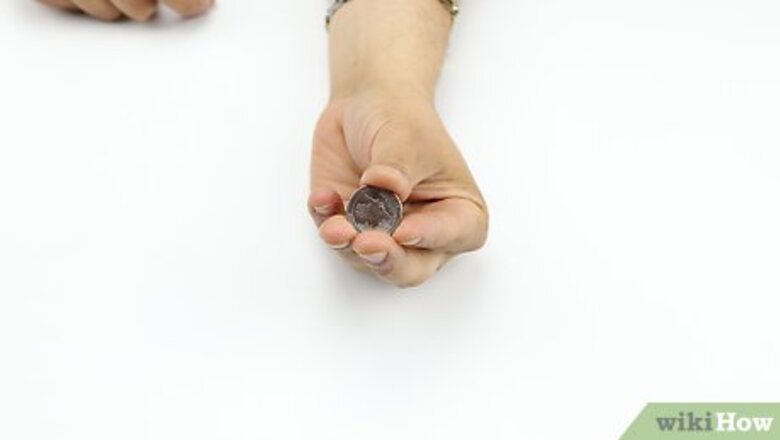
views
Performing the French Drop Coin Vanish
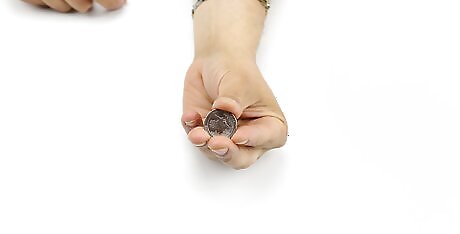
Hold the coin in your left hand. Place the coin between your thumb and first two fingers. You want to be holding the coin on the ridged sides. Make sure your entire hand is slightly tilted towards you. Spectators should be able to see the face of the coin easily, but turning your hand to you will make the trick easier. Use a larger coin, especially if you are a beginner. A quarter or half dollar works well. You can hold the coin in whichever hand feels more comfortable. For the purpose of explaining the trick, the coin will be in the left hand.

Bring your right hand into position. Take your right hand and reach in as if you are about to grab the coin. Position your hand as if you were going to grab the coin with your thumb coming in under the coin. Bring your four fingers over the top of the coin. When reaching in, you want your thumb to go under the coin to give the illusion that you are going to grab it. . By bringing your four fingers over the coin, you can block the drop that you are about to perform.
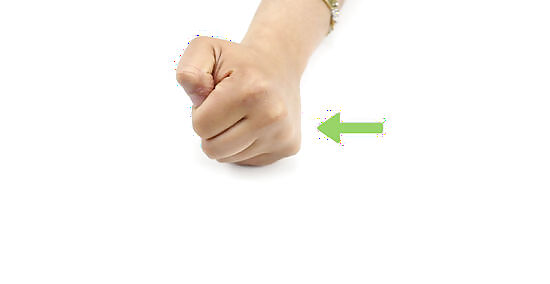
Palm your coin. As your right hand begins to close over the coin, drop it into the palm of your left hand. Turn your left hand over as you squeeze your right hand, drawing it away. As you drop the coin to palm it, squeeze your right hand over your left thumb. Doing this will make it look like you're grabbing the coin. Then pull your left thumb out. Create misdirection here by moving your right hand, the one without the coin, away from your left. People will expect that the coin is in your right hand and follow your movement. You can even rub your fingers together and clench your fist as if you are dissolving the coin into thin air.

Create more misdirection. Bring your left hand with the coin in it down to your leg. Keep moving your right hand, the one that is supposed to have the coin away and up toward your face. By moving your hands in opposite directions and bringing one hand up to people’s eye level, you will force the attention onto your right hand. This allows you to hide the coin away or adjust it under the palm of your left hand without anyone noticing.

Reveal your empty hand. Now open your hand and show the audience that the coin has vanished. You can rub your fingers together, slowly opening your palm as if you dissolved the coin. This constant movement may further help to distract audiences, especially if you are new to the trick. You can also simply open your hand with a bit of a flourish to reveal that the coin has vanished.
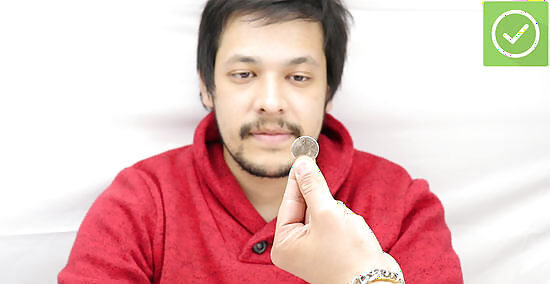
Make the coin reappear. Finish the trick by making the coin reappear behind someone’s ear. Palm the coin in your left hand and quickly bring it up to someone’s ear, pretending to pull it out. This has to be done quickly but can add a nice touch. You could also secretly put the coin in your pocket while revealing your empty right hand. Then reveal that you don’t have the coin in your left hand either, showing that it has disappeared forever.
Levitating or Balancing A Dollar Bill
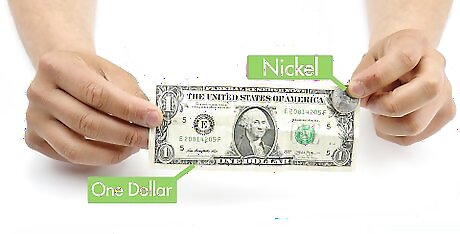
Grab a nickel and a dollar. For this trick, you need to do a little bit of preparation. Grab a nickel and palm it. Then grab a dollar from your wallet, or ask someone for a dollar bill. The nickel will be used to balance the folded dollar on your thumb. Your audience shouldn’t know that you have the nickel. This is a simple trick to do pretty much anywhere. A nickel works well because it’s small and heavy enough to provide a counterbalance.
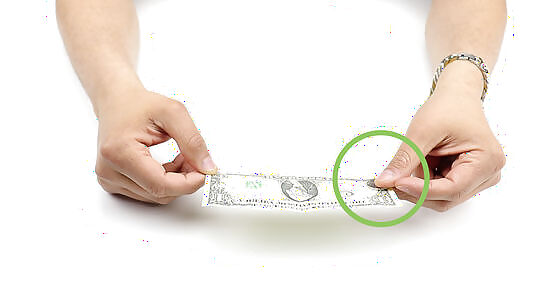
Show the dollar bill. Pinch and hold the bill between your thumbs and first two fingers. When you grab the bill, place the nickel on the back of it, holding it in place between your thumb and forefinger. Fold the bill in half, hamburger style, away from you. Then unfold the bill from the back to show the other side of the bill. What you are doing here is showing that this is an ordinary bill. While you are unfolding it, you are flipping the bill while keeping the nickel in place with your thumb. This is a simple flourish move. While doing this, talk to your audience explaining that there is nothing magical or special about this bill.
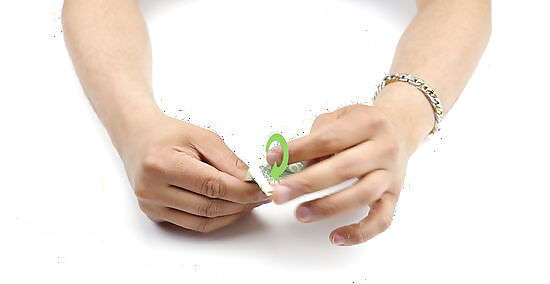
Fold your bill around the nickel. Fold the bill in half the long way, hot dog style. With the nickel still placed on the backside of the bill, fold the bill up. Keep the nickel in place with your thumb and middle finger while you fold the half of the bill down and toward you with your index fingers. Then fold your bill in half again. You will now have a bill that’s folded into fourths. Keep the nickel pinched between your thumb and middle finger, sliding it down to the lower half of your bill. This will allow you to fold the upper half over it. Once you’ve folded the bill in half, position it so the crease is on the bottom and the two open ends are at the top. Let the nickel slide down into the crease. Then, using the same folding method, fold the top of the bill down toward you again. Pinch and crease the folds with your free hand. This will help to trap the nickel in place.
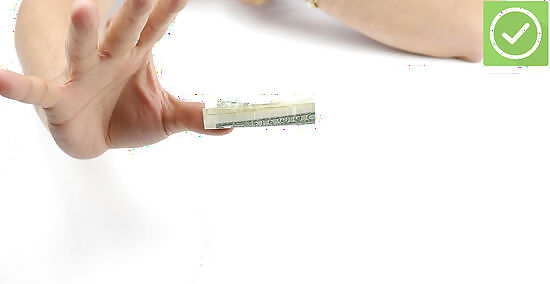
Balance or “levitate” the bill. With the nickel at one end of the bill, pinch the ends of the bill between your thumbs and forefingers. Slowly release your grip on the bill with the hand that is not holding the nickel. While you do this, release your forefinger that is pinching the nickel. The nickel will balance on your thumb, making it look like you are slightly levitating the bill. You can turn your hands slightly and position your other fingers to block the view of your thumb which is balancing the bill for more of an effect. If you have a good sense of balance, you can also move your hand up and down slightly to give some motion to the trick. Keep talking to help distract your audience. Explain how you are using your magical energy to float or levitate the dollar.

Give the dollar back for inspection. After you’ve levitated the bill for a few seconds, let the audience inspect it. Pinch the bill on the side with the nickel and tilt the bill up vertically. Let the nickel fall out and into your palm. Keep the nickel hidden and hand the bill off. You may have to loosen the folds on the bill slightly to get the nickel to drop. When you hand the bill over, quickly slide the nickel into your pocket while the audience is distracted.
Performing the Cut and Run Card Trick
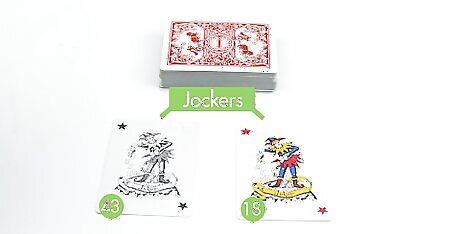
Grab a deck of cards. This is a simple card trick that uses math and has even fooled some of the most talented magicians like Penn & Teller. To start grab a regular deck of cards. This trick does involve a bit of preparation. You will take the two Jokers and place each in the deck facing the opposite direction from the rest of the deck. To help you with practicing, you can write the number 43 on one Joker, and the number 18 on the other. During the performance of this trick you don’t need to have these numbers written on your Joker cards, you just need to remember each number.
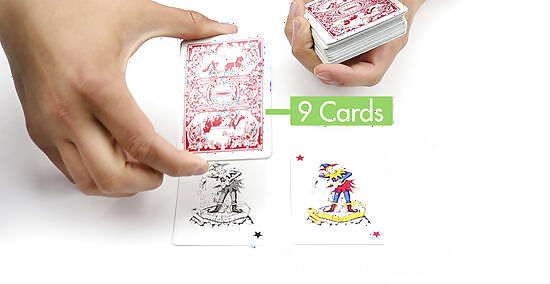
Set the cards up. You are setting your cards up in positions 9, 18, and 25. Deal out 9 cards and place the higher Joker, number 43 face up, on the bottom of that pile. Then deal out 18 cards, placing the number 18 Joker face up on the bottom of that pile. Place your pile of 18 with the Joker under your first pile. You will now have the 25 remaining cards. Place that pile on the bottom. You have now placed the Jokers in the 10 and 29 positions in your deck. This allows you to ask a spectator to cut a third of the deck. It is unlikely that the spectator will cut before the 10th card, your first Joker, and after the 29th card, your second Joker.
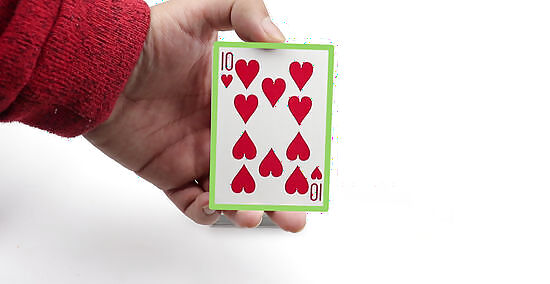
Ask the first spectator to cut about a third of the deck. You can lay the deck on the table and ask your fist spectator to cut a third of the deck and remember the bottom card. Once the deck is cut, place the pile that was cut from the deck down on the table. If you don’t feel confident that your spectator will cut the deck correctly, you can hold the deck and run your thumb along the edges of the card asking the spectator to say stop. This will give you control over how fast you go, ensuring that when a third of the deck is cut, it is after the first Joker and before the second.
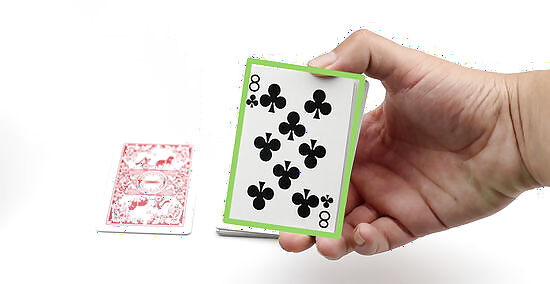
Ask the second spectator to cut half the cards. Using the remaining deck, have your spectator cut this portion of the deck in half. It is unlikely the cut will be made above the second Joker as it is now toward the top. Ask your spectator to remember the card and place the cut portion of the deck on the table next to your first cut. Once again, if you want to ensure that the cut is correct, run your thumb along the edges of the cards and have your spectator tell you to stop at about the halfway point.

Place the cards back into a single pile. You will now have three piles of cards, roughly of equal numbers. Take Spectator One’s pile, the first one you cut, and place it back on top of the remaining deck. Then take Spectator Two’s pile and place it on top of that. You are now taking the first third that was cut and placing it in the middle of your deck while taking the second cut and placing it on the top of the pile.
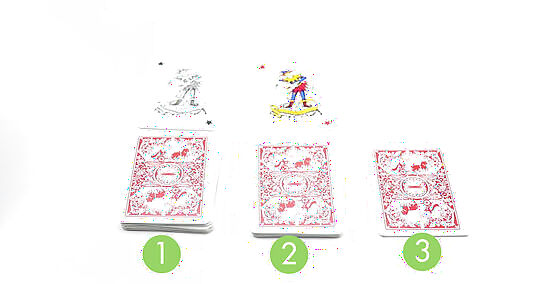
Fan the cards out and slide out the Jokers. Fan the cards out horizontally. Take the Jokers and slide each out, creating a break after each one. You will have three separate piles again. The Joker should be the last card in your break. So when you separate the cards, the card to the right of each Joker is the bottom card on the first two piles. You will once again have three piles of cards. The pile to the far left is Spectator Two’s pile. The pile to the far right is Spectator One’s pile.

Place the piles back into a deck. Take the far left pile, Spectator Two’s pile, and place it on top of the middle pile. The take Spectator One’s pile, on the far right, and place it on top. When placing the cards back into one deck, leave the Jokers out. Your deck will now be in the original order it was, minus the Jokers.

Find the Spectators’ cards. Point to the Joker on the right. Say that this Joker knows where Spectator One's card is, and has whispered the location to you. Count out 18 cards, flipping the 18th card over. This last card will be Spectator One’s card. Point to the other Joker and say this one will tell you the location of the second card. Continue counting up from 18 to get to the 43rd card, which is Spectator Two’s card. Flip it over to reveal. This trick uses simple math to help you find the cards. The Jokers mark the number of cards you will count to find the right ones. The way to remember the positions of cards is simple. The first position, 9, when doubled is 18. 18+25=43, which is the position of the second card. During the trick, keep your audience engaged by spinning a story about two tricky Jokers who have been spying on the cards. These Jokers have been speaking to you, telling where to find the spectators’ cards in the deck.




















Comments
0 comment